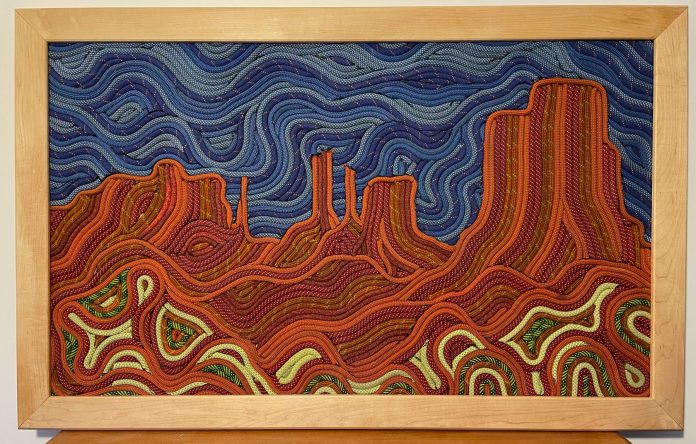Behind the Desk…is an ongoing series that profiles people influencing and advancing the climbing industry across the country. When we heard that there was an artist, Elliot Lacroix, who was working with climbing gyms (and climbers) to turn their old, used ropes into stunning pieces of art…well, we had to learn more. But we soon found that there is more than just creative flair at the heart of Lacroix’s work—there is an intriguing spirit of renewability and sustainability. Lacroix literally uses his art to give fresh life to industry components that would otherwise be discarded. As his website states, the art “came from [Lacroix’s] passion about climbing, environmentalism, and creativity.”
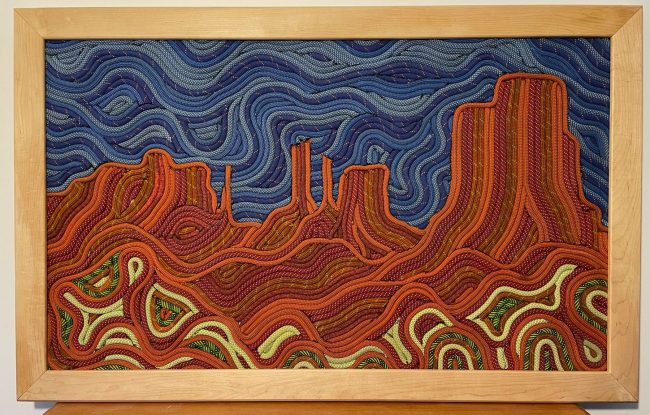
Name: Elliot Lacroix
Title: Artist at End of the Line Design
Instagram: @endoftheline.design
CBJ: Your rope art is so unique, so I’d love to hear a little bit about how the idea to reuse old ropes and give them new life as art came about.
LACROIX: The first piece I made was around five years ago, when I was living in Salt Lake City working at the Front Climbing Club. I was working as their Risk Assessment Manager and as such, I would inspect ropes and retire them when it was time to replace them with new ropes. Once the ropes were retired they would get thrown in a pile behind the climbing walls and forgotten about. It was then that I started thinking about ways to recycle or reuse them—since it seemed like such a waste and they were getting in the way.
I started by making dog leashes and tried making a woven rug. The leashes worked great—but did not use up much rope—and the woven rug took way too long. Then I saw a picture online of someone who had cut the ropes and glued them to make pictures/rugs instead of weaving them. That night I went home, and with a knife, a knife sharpener, a lighter, and a glue gun, I started my first attempt. It took days to complete and I burned my fingers many times to heat the ends of the rope after I cut them. After that I decided to wait to buy a hot knife before making another [laughs]. It wasn’t until this last year and having to put life on hold during Covid that I had time again to make some more pictures and start End of the Line Design.
Do you have any key influences—artistic or otherwise—for your work? Your style is instantly recognizable, so I’m wondering what shaped that.
When asked this question, two answers immediately come to mind. First is Vincent van Gogh and the second is nature. I have always been enthralled by van Gogh’s art. I remember when I was 10 years old, my mother was buying some art prints for our new home we had just moved to. She allowed me to choose a picture and I chose Starry Night. The way van Gogh created movement and his use of color always has inspired my art. I also find inspiration for much of my art from nature. I spend much of my time climbing and living in the southwest desert of Utah, and find the simple and dramatic beauty of the desert to be an amazing sight.
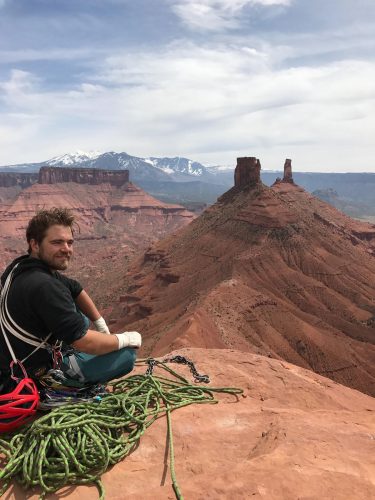
So, what exactly is the process like for creating a rope art piece?
The first step was/is to find ropes. I started by working with the climbing gym I used to work at—and now work with many climbing gyms, as well as individuals to source ropes. Then I design the piece through sketches, and eventually draw it out on a ¼-inch piece of ply that is cut to the size of the picture. Then, I start cutting and gluing ropes on the backside of the picture—so the picture is made upside down and is then flipped over once it is finished.
Once I have finished gluing, I make all the picture frames custom to each picture. After the frame is complete, I glue the rope picture to ply and mount it to the frame.
The most challenging part for me is drawing. I spend a lot of time looking at landscape photos and drawing sketches before moving to the ply to draw up my ideas to scale. Most ideas are either from my imagination and daydreams about being back in the desert…or through discussions with customers on custom pieces.
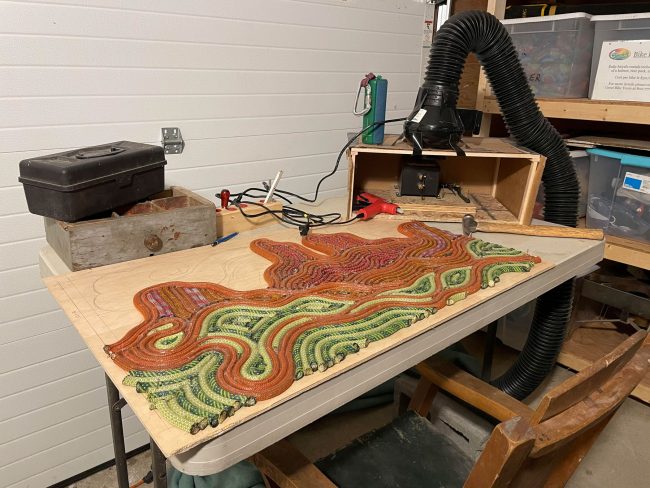
What’s the artistic community like within the climbing industry? I’ve interviewed other artists who create climbing-related or climbing-inspired work, but not many. Are you a close-knit bunch?
Honestly, I am pretty new to the climbing art community. End of the Line Design started in the fall of 2020. Most of my marketing/promotion has been on Instagram and other social media platforms. It wasn’t until I started looking into climbing art that I found more artists doing similar textile work, as well as other, more classical forms of art. In the climbing community, though, I have many friends who make art who find their passion for art and sustainability through their love of climbing.
Even though you admit to being new to the climbing art community, what has been the most challenging thing about being a “climbing artist” so far?
[laughs] Time management. I always want to go climbing or biking or drive off into the woods for an adventure.
There’s a very environmentally conscious aspect to your art—literally giving renewed purpose to ropes that would otherwise be discarded. And I know environmentalism is something you’re passionate about. But environmentalism is obviously such a huge, broad subject. So, is there a specific area of it that you are particularly interested in or passionate about?
I find that people often get overwhelmed when we think of environmentalism or sustainability. I know that I do, and my way of dealing with that has been reflecting on my life and my impact on the environment. I also know that I wanted to give back to my immediate community somehow. It was through this that I started reusing much of what I used to throw away, and where the idea of reusing old ropes came from.
We are always taught Leave No Trace principles these days whenever we go to do recreation outside, but why don’t we do this with all recreation? We throw away so much gear and equipment once it has been used or broken, and only rarely do we have the means to recycle it properly. I guess I am passionate about climbing and dirtbagging and am trying to give back to a community that has been so giving to me over the last 10 years.
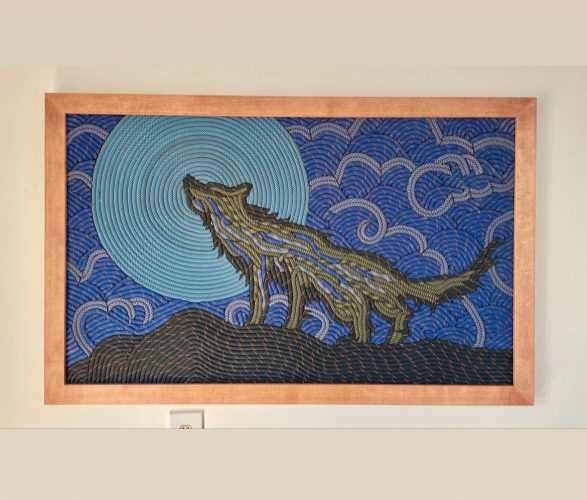
Can gyms or people commission pieces from you? If so, what’s the process for that?
Absolutely! I love making commission pieces! Anyone who is interested in a commission should head over to my website and go to the ‘Contact The Artist’ page. There they can email me and find all information regarding commissions. I usually ask people to send over some pictures of landscapes or ideas of what they want me to make, and then we discuss some options and I draw up some ideas.
You mentioned that a number of gyms have donated old ropes to you for use in your art. If any gyms (or climbers) reading this want to send you their old ropes, what should they do?
I am always accepting retired climbing ropes of any condition. The more colors the better! To anyone interested in donating/recycling their old ropes with End of the Line Design, they can contact me on my website, endofthelinedesign.com.

John Burgman is the author of High Drama, a book that chronicles the history of American competition climbing. He is a Fulbright journalism grant recipient and a former magazine editor. He holds a master’s degree from New York University and bachelor’s degree from Miami University. In addition to writing, he coaches a youth bouldering team. Follow him on Twitter @John_Burgman and Instagram @jbclimbs. Read our interview Meet John Burgman, U.S. Comp Climbing’s Top Journalist.




